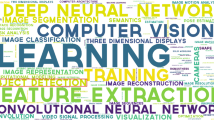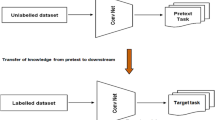Abstract
Clustering is extensively realistic and considered in computer vision that follows unsupervised learning principles. In this, the performance of a clustering process mainly depends on the feature representation. Generally, the clustering process may have an error rate, and this affects the feature representation. To avoid this, unsupervised Learning (USL) provides an alternative path to obtain the best clusters from the dataset through the optimum features. In this proposed work, the clustering process is done by using a hybrid firefly-based flower pollination algorithm (FFPA). So this clustering process removes the complexity in USL. The better performance is obtained by identifying an essential group from the data to avoid the problems obtained by a USL. In the standard USL, the PCA method is used to minimize a large amount of original data. Here, the features are extracted based on RGB features and Zernike moments, and this is given to the input for the hybrid cluster. Finally, the hybrid convolutional neural network classifier, along with the datasets that are trained from a similar patch manifold, is used to create a label for several datasets. The performance of this proposed method portrays that the local features are effectively clustered from the various datasets by an unsupervised FFPA algorithm. In this work, the unsupervised clustering process with a hybrid classification for the object recognition application is used. In this work, the average accuracy, error rate, and run time are nearly 95%, 73%, and 26 s, respectively.








Similar content being viewed by others
References
Ahmad J, Muhammad K, Lloret J, Baik SW (2018) Efficient conversion of deep features to compact binary codes using Fourier decomposition for multimedia big data. IEEE Trans Ind Inform 14:3205–3215
Al Rahhal MM, Bazi Y, AlHichri H, Alajlan N, Melgani F, Yager RR (2016) Deep learning approach for active classification of electrocardiogram signals. Inf Sci 345:340–354
Angadi UB, Venkatesulu M (2012) Structural SCOP super family level classification using unsupervised machine learning. IEEE/ACM Trans Comput Biol Bioinform (TCBB) 9(2):601–608
Ashfaq RAR, Wang XZ, Huang JZ, Abbas H, He YL (2017) Fuzziness based semi-supervised learning approach for intrusion detection system. Inf Sci 378:484–497
Barbu A, She Y, Ding L, Gramajo G (2017) Feature selection with annealing for computer vision and big data learning. IEEE Trans Pattern Anal Mach Intell 39(2):272–286
Barto AG, Anandan P (1985) Pattern-recognizing stochastic learning automata. IEEE Trans Syst Man Cybern 3:360–375
Bhandare A, Bhide M, Gokhale P, Chandavarkar R (2016) Applications of convolutional neural networks. Int J Comput Sci Inf Technol 7:2206–2215
Chen M, Shi X, Zhang Y, Wu D, Guizani M (2017) Deep features learning for medical image analysis with convolutional auto encoder neural network. IEEE Trans Big Data 45:56. https://doi.org/10.1109/TBDATA.2017.2717439
Chen K, Jun H, Jinliang H (2018) Detection and classification of transmission line faults based on unsupervised feature learning and convolutional sparse auto encoder. IEEE Trans Smart Grid 9(3):1748–1758
Chuang MC, Hwang JN, Williams K (2016) A feature learning and object recognition framework for underwater fish images. IEEE Trans Image Process 25(4):1862–1872
Das R, Thepade S, Ghosh S (2017) Novel feature extraction technique for content-based image recognition with query classification. Int J Comput Vis Robot 7(1–2):123–147
Firouzi M, Turinsky A, Choufani S, Michelle TS, Weksberg R, Brudno M (2018) An unsupervised learning method for disease classification based on DNA methylation signatures. bioRxiv 492926
Gao Y, Wang M, Zha ZJ, Tian Q, Dai Q, Zhang N (2011) Less is more: efficient 3-D object retrieval with query view selection. IEEE Trans Multimed 13(5):1007–1018
Griffin G, Holub A, Perona P (2007) Caltech 256 object category dataset. Technical report UCB/CSD-04-1366, California Institute of Technology
Gu K, Tao D, Qiao JF, Lin W (2018) Learning a no-reference quality assessment model of enhanced images with big data. IEEE Trans Neural Netw Learn Syst 29(4):1301–1313
Hosseini SMS, Maleki A, Gholamian MR (2010) Cluster analysis using data mining approach to develop CRM methodology to assess the customer loyalty. Expert Syst Appl 37(7):5259–5264
Jain AK (2010) Data clustering: 50 years beyond K-means. Pattern Recognit Lett 31(8):651–666
Jiang B, Chen H, Yuan B, Yao X (2017) Scalable graph-based semi-supervised learning through sparse Bayesian model. IEEE Trans Knowl Data Eng 29(12):2758–2771
Kalogeratos A, Likas A (2011) Document clustering using synthetic cluster prototypes. Data Knowl Eng 70(3):284–306
Kaushik K, Arora V (2015) A hybrid data clustering using firefly algorithm based improved genetic algorithm. Proc Comput Sci 58:249–256
Kheradpisheh SR, Ganjtabesh M, Masquelier T (2016) Bio-inspired unsupervised learning of visual features leads to robust invariant object recognition. Neurocomputing 205:382–392
Khokher R, Singh RC, Kumar R (2015) Footprint recognition with principal component analysis and independent component analysis. Macromol Symp 347(1):16–26
Lam D, Donald CW (2017) Unsupervised feature learning classification with radial basis function extreme learning machine using graphic processors. IEEE Trans Cybern 47(1):224–231
Lee H, Grosse R, Ranganath R, Ng AY (2011) Unsupervised learning of hierarchical representations with convolutional deep belief networks. Commun ACM 54(10):95–103
Li Y, Tao C, Tan Y, Shang K, Tian J (2016) Unsupervised multilayer feature learning for satellite image scene classification. IEEE Geosci Remote Sens Lett 13(2):157–161
Li J, Cheng K, Wang S, Morstatter F, Trevino RP, Tang J, Liu H (2018) Feature selection: a data perspective. ACM Comput Surv (CSUR) 50(6):94
Lim S, Tucker CS, Kumara S (2017) An unsupervised machine learning model for discovering latent infectious diseases using social media data. J Biomed Inform 66:82–94
Liu H, Qin J, Sun F, Guo D (2017) Extreme kernel sparse learning for tactile object recognition. IEEE Trans Cybern 479(12):4509–4520
Mohammad AL, Khader AT (2017) Unsupervised text feature selection technique based on hybrid particle swarm optimization algorithm with genetic operators for the text clustering. J Supercomput 73(11):4773–4795
Müllner D (2013) Fast cluster: fast hierarchical, agglomerative clustering routines for R and Python. J Stat Softw 53(9):1–18
Niusha S, Lam HL, Rajprasad R, Kallimani VP, Akram NA, Dino I (2016) Using unsupervised clustering approach to train the support vector machine for text classification. Neurocomputing 211:4–10
Singh A, Kingsbury N (2017) Scatternet hybrid deep learning (SHDL) network for object classification. In: IEEE 27th international workshop on machine learning for signal processing (MLSP), pp 1–6
Song W, Li M, Zhang P, Wu Y, Jia L, An L (2017) Unsupervised PolSAR image classification and segmentation using Dirichlet process mixture model and Markov random fields with similarity measure. IEEE J Sel Top Appl Earth Obs Remote Sens 10(8):3556–3568
Sun Y, Norick B, Han J, Yan X, Yu PS, Yu X (2013) Pathselclus: integrating meta-path selection with user-guided object clustering in heterogeneous information networks. ACM Trans Knowl Discov Data (TKDD) 7(3):11
Triguero I, García S, Herrera F (2015) SEG-SSC: a framework based on synthetic examples generation for self-labeled semi-supervised classification. IEEE Trans Cybern 45(4):622–634
Weinberger KQ, Saul LK (2006) Unsupervised learning of image manifolds by semi definite programming. Int J Comput Vis 70(1):77–90
Weston J, Ratle F, Mobahi H, Collobert R (2012) Deep learning via semi-supervised embedding. In: Orr GB, Müller KR (eds) Neural networks: tricks of the trade. Springer, Berlin, pp 639–655
Yang XS (2012) Flower pollination algorithm for global optimization. Lecture Notes in Computer Science (including Subser. Lecture notes in artificial intelligence. Lecture notes in bioinformatics) 7445 LNCS, pp 240–249
Yuan Y, Wan J, Wang Q (2016) Congested scene classification via efficient unsupervised feature learning and density estimation. Pattern Recognit 56:159–169
Zhang W, Zhao D, Wang X (2013) Agglomerative clustering via maximum incremental path integral. Pattern Recognit 46(11):3056–3065
Zhang L, He Z, Liu Y (2017) Deep object recognition across domains based on adaptive extreme learning machine. Neurocomputing 239:194–203
Zhao Y, Karypis G, Fayyad U (2005) Hierarchical clustering algorithms for document datasets. Data Min Knowl Discov 10(2):141–168
Zhu P, Zuo W, Zhang L, Hu Q, Shiu SC (2015) Unsupervised feature selection by regularized self-representation. Pattern Recognit 48(2):438–446
Acknowledgements
No funding is provided for the preparation of the manuscript.
Author information
Authors and Affiliations
Corresponding author
Ethics declarations
Conflict of interest
Authors Kiran Pandurang Somase and S. Sagar Imambi declare that they have no conflict of interest.
Human and animal rights
This article does not contain any studies with human participants or animals performed by any of the authors.
Additional information
Communicated by V. Loia.
Publisher's Note
Springer Nature remains neutral with regard to jurisdictional claims in published maps and institutional affiliations.
Rights and permissions
About this article
Cite this article
Somase, K.P., Imambi, S.S. Develop and implement unsupervised learning through hybrid FFPA clustering in large-scale datasets. Soft Comput 25, 277–290 (2021). https://doi.org/10.1007/s00500-020-05140-y
Published:
Issue Date:
DOI: https://doi.org/10.1007/s00500-020-05140-y




